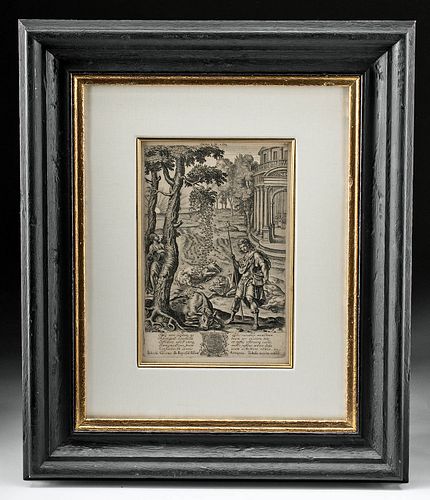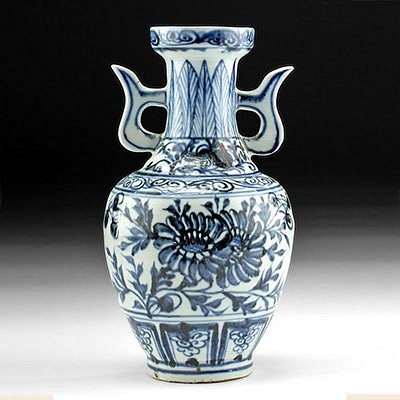Framed Wenceslaus Hollar Etching - Virgil's Georgics
Lot 130
About Seller
Artemis Fine Arts
686 S Taylor Ave, Ste 106
Louisville, CO 80027
United States
Selling antiquities, ancient and ethnographic art online since 1993, Artemis Gallery specializes in Classical Antiquities (Egyptian, Greek, Roman, Near Eastern), Asian, Pre-Columbian, African / Tribal / Oceanographic art. Our extensive inventory includes pottery, stone, metal, wood, glass and textil...Read more
Categories
Estimate:
$600 - $900
Absentee vs Live bid
Two ways to bid:
- Leave a max absentee bid and the platform will bid on your behalf up to your maximum bid during the live auction.
- Bid live during the auction and your bids will be submitted real-time to the auctioneer.
Bid Increments
| Price | Bid Increment |
|---|---|
| $0 | $25 |
| $300 | $50 |
| $1,000 | $100 |
| $2,000 | $250 |
| $5,000 | $500 |
| $10,000 | $1,000 |
| $20,000 | $2,500 |
| $50,000 | $5,000 |
| $100,000 | $10,000 |
| $200,000 | $20,000 |
About Auction
By Artemis Fine Arts
Nov 19, 2020
Set Reminder
2020-11-19 10:00:00
2020-11-19 10:00:00
America/New_York
Bidsquare
Bidsquare : Ancient Treasures & Holiday Jewelry
https://www.bidsquare.com/auctions/artemis-gallery/ancient-treasures-holiday-jewelry-6035
Travel around the world and back in time and be amazed at the treasures you will find! Antiquities from Egypt, Greece, Italy and the Near East, Asian, Pre-Columbian, African/Tribal/Oceanic, Native American, Spanish Colonial, Fine Art, much more. Shop early for the holidays! Artemis Fine Arts info@artemisfinearts.com
Travel around the world and back in time and be amazed at the treasures you will find! Antiquities from Egypt, Greece, Italy and the Near East, Asian, Pre-Columbian, African/Tribal/Oceanic, Native American, Spanish Colonial, Fine Art, much more. Shop early for the holidays! Artemis Fine Arts info@artemisfinearts.com
- Lot Description
Wenceslaus Hollar (Czechoslovakian, 1607-1677). Etching from Virgil's Georgics Book IV. State unknown. Possibly late 17th c. A marvelous etching by respected 17th century Bohemian graphic artist Wenceslaus Hollar (also known as Wenzel Hollar and Vaclav Hollar), who spent much of his life in England and is known for his engravings and etchings. The composition features a scene from Virgil's Georgics Book IV, with the protagonist Aristaeus in the wood amidst four dying oxen, a sprite behind the tree, the rising sun in the distance suggesting it is dawn, and an architectural shrine or temple at the right. Size: plate - 11.375" L x 7.625" W (28.9 cm x 19.4 cm); 24.75" L x 20.75" W (62.9 cm x 52.7 cm) framed
This text from Georgics perhaps captures the scene, "He comes to the shrine, raises the altars appointed, and leads there four choice bulls, of surpassing form, and as many heifers of unyoked neck. Later, when the ninth Dawn had ushered in her rising beams, he offers to Orpheus the funeral dues, and revisits the grove. But here they espy a portent, sudden and wondrous to tell—throughout the paunch, amid the molten flesh of the oxen, bees buzzing and swarming forth from the ruptured sides, then trailing in vast clouds, till at last on a treetop they stream together, and hang in clusters from the bending boughs."
Although Hollar came of age when Prague was experiencing a flourishing of all the arts, his family did not support his interests. So he elected to go to Germany at age of twenty. There he met a well-known patron of the arts, the Earl of Arundel, who asked Hollar to come to England and create etchings of his large collection of Renaissance art. By 1652, Hollar was working for the publisher John Ogilby and the antiquary Sir William Dugdale. He would create 566 etching plates of architectural and topographical compositions over the next twenty five years. Following this, Ogilby asked Hollar to create etchings after Francis Cleyn's designs for the impressive 1654 pictorial edition of Virgil, the Roman poet (70 to 19 BCE) who wrote the Aeneid. According to Doggett, Brobeck, and Biggs, "Interestingly, both etching and engraving techniques were used on the same plates rsulting in a more 3-dimensional quality upon the images." (Source: Biggs, Julie L., Brobeck, Carol, Rachel Doggett. Impressions of Wenceslaus Hollar. Washington D.C. The Folger Shakespeare Library, 1996.)
Provenance: ex Estate of Eldert Bontekoe, Pegasi Numismatics, Ann Arbor, Michigan USA acquired before 2000
All items legal to buy/sell under U.S. Statute covering cultural patrimony Code 2600, CHAPTER 14, and are guaranteed to be as described or your money back.
A Certificate of Authenticity will accompany all winning bids.
We ship worldwide and handle all shipping in-house for your convenience.
#159226This piece has not been examined outside the frame but appears to be in very good condition with nice plate marks. Framing dates later than the print but compliments it nicely. On verso is a nice artist biography about Hollar from the Wentworth Gallery. Wired for suspension and ready to hang.Condition
- Shipping Info
-
All shipping is handled in-house for your convenience. Your invoice from Artemis Gallery will include shipping calculation instructions. If in doubt, please inquire BEFORE bidding for estimated shipping costs for individual items.
-
- Buyer's Premium



 EUR
EUR CAD
CAD AUD
AUD GBP
GBP MXN
MXN HKD
HKD CNY
CNY MYR
MYR SEK
SEK SGD
SGD CHF
CHF THB
THB
















